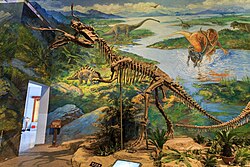| Yandusaurus Temporal range: Middle Jurassic,
| |
|---|---|

| |
| Life reconstruction of Yandusaurus | |
| Scientific classification | |
| Domain: | Eukaryota |
| Kingdom: | Animalia |
| Phylum: | Chordata |
| Clade: | Dinosauria |
| Clade: | †Ornithischia |
| Clade: | †Neornithischia |
| Genus: | †Yandusaurus He, 1979 |
| Species: | †Y. hongheensis
|
| Binomial name | |
| †Yandusaurus hongheensis He, 1979
| |
Yandusaurus is a genus of herbivorous basal neornithischian dinosaur from the Bathonian age (middle Jurassic, approximately 168 to 162 Ma) of China.

Discovery and naming
[edit]In January 1973 the Museum of the Salt Industry at Zigong in Sichuan was warned that during construction activities with a composter at Jinzidang near the Honghe dam inadvertently a dinosaur skeleton had been processed. A team of the museum managed to salvage some heavily damaged remains. Though locally this animal was at first referred to as "Yubasaurus" or "Honghesaurus", in 1979 Beijing professor He Xinlu named and described it as the type species Yandusaurus hongheensis. The generic name is derived from Yandu, the ancient name for Zigong. This name is a contraction of yan, "salt", and du, "capital", occasioned by the fact that Zigong was historically the centre of Chinese salt mining. In this way Yandusaurus indirectly also refers to the Salt Museum. The specific name refers to the Honghe river.[1]
The holotype specimen, GCC V20501, had been dug up in a layer of the Lower Shaximiao Formation. It consists of a partial skeleton with skull. Elements of most parts of the body have been preserved, the skull, vertebral column, shoulder girdle, frontlimbs and hindlimbs but all are very limited and/or damaged. The lower jaws, pelvis and the end of the tail had probably been entirely destroyed by the machine.[2]
In 1983 He and Cai Kaiji identified a second species: Yandusaurus multidens, known from two nearly complete skeletons and nine partial skeletons.[3] In 1992 this was by Guangzhao Peng reassigned to the genus Agilisaurus as a A. multidens. In 1996 Gregory S. Paul renamed it as Othnielia multidens. In 2005 it was by Paul Barrett e.a. placed in its own genus, Hexinlusaurus.[4]
Description
[edit]A fast-moving biped, Yandusaurus had four toes on each foot and five fingers on each hand. It had large eyes as shown by the curved jugal. The teeth, showing a unique pattern of parallel vertical ridges compared by Chinese researchers to the fingers of the hand of Buddha statues, are very asymmetrical in that the inner side is strongly worn down. The fifteen maxillary teeth are largest in the middle and overlap.[2]
When indicating the size of Yandusaurus many sources give that of Hexinlusaurus, the previous Y. multidens, the (all juvenile) specimens of which are sixty centimetres (two feet) to 1.6 metres (5 ft) in length, and weighed around seven kilograms (fifteen lb). Yandusaurus hongheensis was however considerably larger than these exemplars: He estimated the body length at three metres,[2] Peng at 3.2 metres; in 2010 G.S. Paul gave an estimation of 3.8 metres length and a weight of hundred forty kilogrammes.[5]
Phylogeny
[edit]Yandusaurus was assigned by He to the Hypsilophodontidae.[1] Today however Hypsilophodontidae is considered an unnatural (paraphyletic) group and Yandusaurus is viewed as taking an unresolved position within Neornithischia.[6][7]
Notes
[edit]- ^ a b He X., 1979, "A newly discovered ornithopod dinosaur Yandusaurus from Zigong, Sichuan". In: Contributions to International Exchange of Geology. Part 2. Stratigraphy and paleontology. Geol. publishing House, Beijing: pp. 116-123
- ^ a b c He, X. & Cai, K., 1984, The Middle Jurassic dinosaurian fauna from Dashampu, Zigong, Sichuan. Vol. 1: The ornitopod dinosaurs. Sichuan Scientific and Technological Publishing House, Chengdu, Sichuan, pp. 1-71
- ^ He, X.-L. & Cai, K.-J., 1983, "A new species of Yandusaurus (hypsilophodont dinosaur) from the Middle Jurassic of Dashanpu, Zigong, Sichuan", Journal of Chengdu College of Geology Supplement 1: 5-14
- ^ Barrett, P.M., Butler, R. J., and Knoll, F., 2005, "Small-bodied ornithischian dinosaurs from the Middle Jurassic of Sichuan, China", Journal of Vertebrate Paleontology 25: 823-834
- ^ Paul, G.S., 2010, The Princeton Field Guide to Dinosaurs, Princeton University Press p. 274
- ^ Bulter, Richard J.; Upchurch, Paul; Norman, Dasvid B. (2008). "The phylogeny of the ornithischian dinosaurs". Journal of Systematic Palaeontology. 6 (1): 1–40. Bibcode:2008JSPal...6....1B. doi:10.1017/S1477201907002271. S2CID 86728076.
- ^ Boyd, Clint A. (2015). "The systematic relationships and biogeographic history of ornithischian dinosaurs". PeerJ. 3 (e1523): e1523. doi:10.7717/peerj.1523. PMC 4690359. PMID 26713260.